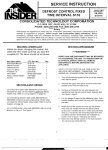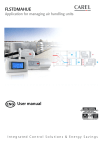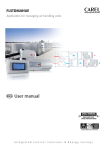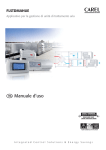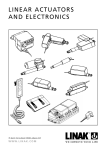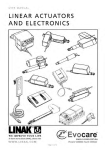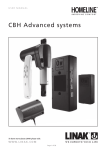Download Ford 2003 Mustang Automobile User Manual
Transcript
INSTALLATION & OPERATION MANUAL Single Package Vertical Air Conditioning System B – Series 18,000 – 24,000 – 30,000 – 36,000 – 42,000 – 49,000 – 60,000 Btuh 840-170-38 TABLE OF CONTENTS Vert-I-Pak B-Series Vertical Air Conditioning System Page I. II. III. 1. 2. 3. 4. IV. 2 Safety Considerations ....................................................................................................... 3 General Recommendations ............................................................................................... 3 Unpacking and Inspecting the Unit .................................................................................... 3 Supplies Needed for Installation ........................................................................................ 3 General Specifications Model Number Identification Guide ................................................................................... 4 B-Series Chassis Specifications ........................................................................................ 4 Dimensional Data V(E,H)B18,24,30,36 Unit Dimensions ................................................................................ 5 V(E,H)B24,49 Unit Dimensions ......................................................................................... 6 V(E,H)B60 Unit Dimensions .............................................................................................. 6 Installation Indoor and Outdoor Air Requirement ................................................................................. 4-5 A. Outdoor Air System ....................................................................................................... 7-9 B. Ducted Condenser Air .................................................................................................. 10 Outdoor Fan Performance .................................................................................. 10 C. Indoor Air (Conditioned Supply air System .................................................................. 11 Indoor Fan Performance ............................................................................................. 12 Electrical A. Grounding ........................................................................................................... 12 B. Power Supply ...................................................................................................... 12 Thermostat Mounting and Wiring ...................................................................................... 13-14 A. Thermostat Location ........................................................................................... 13 B. Thermostat Mounting & Wiring ........................................................................... 13 C. Wire Thermostat Cable to Unit Terminal ............................................................. 13 Condensate Drain Line ...................................................................................................... 14 Installation – Final Checklist .............................................................................................. 14 Test Run ........................................................................................................................... 14 Owners Manual & Operating Information Identifying your System ..................................................................................................... 15 Important Facts ................................................................................................................. 15 Operating the Vert-I-Pak .................................................................................................... 16 Thermostat Operation ....................................................................................................... 16 Cooling Cycle .................................................................................................................... 17 Heating Cycle .................................................................................................................... 17 Defrost Cycle ..................................................................................................................... 17 Performing Routing Maintenance ...................................................................................... 18 Replace the Air Filter ......................................................................................................... 18 Inspect and Cleaning the Indoor Air Coil ............................................................................ 19 Inspect the Outdoor Air Intake and Exhaust ...................................................................... 19 Inspect and Clean the Condensate Drain .......................................................................... 19 SAFETY CONSIDERATIONS Improper installation, adjustment, alteration, service, maintenance, or use can cause explosion, fire, electrical shock, or other conditions which may cause personal injury or property damage. Consult a qualified installer, service agency, or your distributor or dealer for information and assistance. The qualified installer or agency must use factory-authorized parts or accessories when modifying this product. Refer to the individual instructions packaged with the parts or accessories when installing. Follow all safety codes. Wear safety glasses and work gloves. Read these instructions thoroughly and follow all warnings or cautions attached to the unit. Always install units in accordance with local building codes, the National Electric Code (NEC), and the Installation Standards, Warm Air Heating and Air Conditioning Systems ANSI/NFPA 90B for special installation requirements. GENERAL RECOMMENDATIONS (DO'S AND DON'T'S) ● ● ● ● ● ● ● ● ● ● ● ● ● ● ● ● ● ● ● DO read the instructions completely before installation. DO take time to perform a quality installation. DO NOT obstruct or restrict indoor or outdoor air paths. When using flex duct: DO install properly. DO NOT crush or make sharp bends in flex duct, use only gradual bends. DO tape and seal all duct joints. DO check the indoor conditioned air duct system static pressure losses. It should not exceed those listed in Table 2. Consult your dealer or distributor for more information. When designing indoor supply systems, DO NOT reduce air intakes or discharge sizes. DO insulate ALL conditioned air duct system components. DO NOT locate room thermostat near conditioned air diffusers. DO locate thermostat on an interior wall. DO check that condensate drain line drains freely. DO NOT let debris fall and collect in indoor or outdoor blowers. DO NOT drill into unit (except for 1 in. flanges for ducted return units). This could cause a refrigerant leak. DO handle unit with care. DO provide minimum installation and service clearances. DO build closet so that unit may be removed if necessary. DO follow all guidelines for indoor and outdoor air system. DO NOT substitute any components without checking with your dealer or distributor. If you do substitute, get approval in writing. Substitutions without approval void unit warranty. DO NOT guess, consult your dealer or distributor if any portion of the installation procedure is unclear. UNPACK AND INSPECT UNIT Remove shipping protection and pallet from unit and inspect for damage. Be sure to check for concealed internal shipping damage. Do not install a damaged unit. SUPPLIES NEEDED FOR INSTALLATION The following items are required to install unit. ● Adhesive, aluminum duct tape. CAUTION: Incorrect type of duct tape may be a fire hazard. A failure to follow this warning could result in a fire and personal injury or death. ● 6-conductor thermostat cable (20 gage wire minimum). CAUTION: Do not use thermostat wire with less than the recommended number of conductors. ● ● ● ● ● Supplies to connect indoor air (conditioned air supply) duct to unit. Supplies to connect power to unit. Supplies to connect outdoor-air duct to unit. Supplies to connect condensate drain line. Supplies to connect low-voltage thermostat to unit. 3 Section I – General Specifications VERT-I-PAK® MODEL IDENTIFICATION GUIDE MODEL NUMBER SERIES V=Vertical Series E=Cooling with or without electric heat H=Heat Pump DESIGN SERIES A = 32" Cabinet B = 68" Cabinet NOMINAL CAPACITY B-Series (Btu/h) 18 = 18,000 36 = 36,000 60 = 60,000 24 = 24,000 42 = 42,000 30 = 30,000 49 = 49,000 VOLTAGE K = 208/230V-1Ph-60Hz V H B 36 K 10 RT A ENGINEERING CODE OPTIONS RT = Standard Remote Operation ELECTRIC HEATER SIZE B-Series 05 = 5.0 KW 10= 10.0 KW 15 = 15.0 KW 20 = 20.0 KW 25 = 25.0 KW B-SERIES CHASSIS SPECIFICATIONS M O D E L S : C O O L I N G V(E,H)B18K05 V(E,H)B24K05 V(E,H)B24K10 V(E,H)B30K10 V(E,H)B30K15 V(E,H)B36K10 V(E,H)B36K15 Cooling Cap. 17000 17000 22000 22000 30000 30000 35000 35000 Cooling Power (W) 1700 1700 2200 2200 2900 2900 3500 3500 SEER 10.0 10.0 10.0 10.0 10.0 10.0 10.0 10.0 Cooling SHR 0.78 0.78 0.75 0.75 0.70 0.70 0.70 0.70 E L E C T R I C A L Heater Size (KW) H E A T D A T A : 5.0 10.0 5.0 10.0 10.0 15.0 10.0 15.0 Heating Cap. (Btu/h) 17050 34100 17050 34100 34100 51150 34100 51150 Heating Power (W) 5000 10000 5000 10000 10000 15000 10000 15000 Heating Current (A) 20.8 41.6 20.8 41.6 41.6 62.4 41.6 62.4 H E A T P U M P D A T A : Heating Cap. (Btu/h) 17000 17000 22000 22000 30000 30000 34000 34000 Heating Power (W) 1650 1650 2000 2000 2600 2600 3300 3300 Heating Current (A) 7.3 7.3 9.3 9.3 12.0 12.0 15.0 15.0 COP 3.0 3.0 3.2 3.2 3.2 3.2 3.0 3.0 230/208 230/208 230/208 230/208 230/208 230/208 230/208 230/208 42.5 42.5 56.0 56.0 72.5 72.5 88.0 88.0 (14) 26 (14) 52 (16.7) 26 (16.7) 52 (22.8)52 (22.8)26,52 (27.9)52 (27.9) 26,52 Hard Wire Hard Wire Hard Wire Hard Wire Hard Wire Hard Wire Hard Wire Hard Wire E L E C T R I C A L Voltage (V) LRA - Comp. (A) Min. Ckt. Amps (A)+ Power Connection P H Y S I C A L D A T A : D A T A : Unit Width (in.) 30.00 30.00 30.00 30.00 30.00 30.00 30.00 30.00 Unit Depth (in.) 21.00 21.00 21.00 21.00 21.00 21.00 21.00 21.00 Unit Height (in.) 68.00 68.00 68.00 68.00 68.00 68.00 68.00 68.00 320 320 320 320 330 330 340 340 1050 Shipping Weight (lbs.) A I R F L O W 4 V(E,H)B18K10 D A T A : D A T A : Indoor CFM 640 640 800 800 1000 1000 1050 Fresh Air CFM 65 65 65 65 65 65 65 65 Indoor Motor 1/3 1/3 1/3 1/3 1/3 1/3 1/3 1/3 Indoor Motor Amps 1.0 1.0 1.0 1.0 1.8 1.8 2.5 2.5 Outdoor Motor 1/3 1/3 1/3 1/3 1/3 1/3 1/2 1/2 Outdoor Motor Amps 1.4 1.4 1.4 1.4 2.2 2.2 3.0 3.0 M O D E L S : C O O L I N G V(E,H)B42K10 V(E,H)B42K15 V(E,H)B49K15 V(E,H)B49K20 V(E,H)B60K20 V(E,H)B60K25 D A T A : Cooling Cap. 42000 42000 48500 48500 58000 58000 Cooling Power (W) 4500 4500 5500 5500 6450 6450 SEER 9.8 9.8 9.8 9.8 9.9 9.9 Cooling SHR 0.72 0.72 0.69 0.69 0.72 0.72 E L E C T R I C A L Heater Size (KW) H E A T 15.0 15.0 20.0 20.0 25.0 Heating Cap. (Btu/h) 34100 51150 51150 68200 68200 85250 Heating Power (W) 10000 15000 15000 20000 20000 25000 Heating Current (A) 41.6 62.4 62.4 83.2 83.4 104.2 P U M P D A T A : Heating Cap. (Btu/h) 40000 40000 47000 47000 59000 59000 Heating Power (W) 4000 4000 4800 4800 5636 5636 Heating Current (A) 19.0 19.0 22.0 22.0 25.0 25.0 COP 3.0 3.0 3.0 3.0 3.0 3.0 230/208 230/208 230/208 230/208 230/208 230/208 104.0 104.0 129.0 129.0 169.0 169.0 (33) 52 (33) 26,52 (40.5) 26,52 (40.5 ) 52,52 (49) 52, 52 (49), 26, 52, 52 Hard Wire Hard Wire Hard Wire Hard Wire Hard Wire Hard Wire E L E C T R I C A L Voltage (V) LRA - Comp. (A) Min. Ckt. Amps (A) + Power Connection P H Y S I C A L D A T A : D A T A : Unit Width (in.) 38.00 38.00 38.00 38.00 45.00 45.00 Unit Depth (in.) 28.00 28.00 28.00 28.00 30.50 30.50 Unit Height (in.) 68.00 68.00 68.00 68.00 77.00 77.00 440 440 460 460 540 540 1800 Shipping Weight (lbs.) A I R F L O W Indoor CFM Value in ( ) is for the unit power. Value outside of ( ) is for electric heat only. See Page 12. D A T A : 10.0 H E A T + D A T A : 1400 1400 1400 1400 1800 Fresh Air CFM 70 70 70 70 70 70 Indoor Motor 1/2 1/2 1/2 1/2 1/2 1/2 Indoor Motor Amps 3.0 3.0 3.0 3.0 3.1 3.1 Outdoor Motor 3/4 3/4 3/4 3/4 1/3 (2) 1/3 (2) Outdoor Motor Amps 4.7 4.7 4.7 4.7 5.0 5.0 Section II – Dimensional Data Figure 1 V(E,H)B18,24,30,36 Unit Dimensions (Inches) CONDENSATE DRAIN EXIT 2" ABOVE FLOOR 5 Figure 2 V(E,H)B42, 49 Unit Dimensions (Inches) Figure 3 V(E,H)B60 Unit Dimensions (Inches) Section III – Installation TheVert-I-Pak was designed for installation in residential and light commercial applications. These instructions detail a typical method of installation. Figure 4 shows the typical component location and airflow paths through the unit. Units are available in three return air configurations: front "free-return" with disposable filter; front ducted return with 1" duct flange; and left side ducted return with 1" duct flange. See Figure 10 on Page 11. 6 Figure 4 Unit Configuration 1) INDOOR AND OUTDOOR AIR REQUIREMENTS The indoor and outdoor air systems are designed to operate at specified airflow rates and external static pressures. The supply and return air duct system pressure losses (including filter, louver/grille and registers) must not exceed the listed external static pressures for either the indoor or outdoor air systems. CAUTION: Failure to adhere to indoor air and outdoor air requirements as listed in the following sections will void unit warranty. A. Outdoor Air System As a completely self-contained system, the Vert-I-Pak unit requires an adequate supply of outdoor air to exchange heat from the outdoor air coil. The outdoor air intake and discharge openings are located on the back side of the unit. The unit may be installed where the outdoor air path runs through the wall of the building directly behind the unit or where the outdoor air intake and discharge paths are ducted separately away from the unit. Figure 9 shows two typical ducted OA designs. CAUTION: To ensure proper operation, the outdoor air intake and discharge air paths must be free and unobstructed. The two air paths must be situated to ensure that the intake and discharge air do not recirculate (also called short-circuit). 7 Figure 5 VPBWP3 – 8/14 Wall Plenum For Models • VE/VHB18 • VE/VHB24 Figure 6 VPBWP4 – 8/14 Wall Plenum For Models • VE/VHB18 • VE/VHB24 • VE/VHB30 • VE/VHB36 8 Figure 7 VPBWP5 – 8/14 Wall Plenum For Models • VE/VHB42 • VE/VHB49 Figure 8 VPBWP6 – 8/14 Wall Plenum For Model • VE/VHB60 9 B.. Ducted Condenser Air For ducted outside air applications, the combined pressure losses of the intake and discharge air paths must not exceed the external static capabilities of the system at the design airflow (See Table 3). Outdoor Fan Performance Table 1 Model 0.1 0.2 0.3 0.4 0.5 VE/HB18 1300 1180 1100 950 790 VE/HB24 1300 1180 1100 950 790 VE/HB30 1300 1200 1100 1000 810 VE/HB36 1730 1660 1600 1560 1400 VE/HB42 2100 2000 1900 1800 1700 VE/HB49 2600 2500 2400 2300 2100 VE/HB60 2990 2900 2800 2670 2450 Note: Italic type indicates performance outside the required operating window of ± 10% of rated SCFM. Figure 9 Typical Ducted Outside Air Configuration INTAKE EXHAUST EXHAUST CEILING CEILING BACK OF UNIT OUTDOOR AIR INTAKE OUTSIDE WALL OUTDOOR AIR INTAKE OUTSIDE WALL OUTSIDE WALL FLOOR OUTDOOR AIR EXHAUST FLOOR OUTDOOR AIR EXHAUST INTAKE 10 C. Indoor-Air (Conditioned Supply Air) System The VEB/VHB series unit may be applied in either a free return air configuration or a ducted return air configuration. The supply air path is intended to be ducted. The design and construction of the indoor-air system must provide adequate air distribution to ensure comfort levels throughout the structure. The combined pressure losses of the return and supply air paths must not exceed the external static capabilities of the system at the design airflow (See Table 2). If the unit is installed in a closet behind a door and the return air louver or grille is directly opposite the unit RA opening, 2in. clearance is required between the front of the unit and the back side of the louver or grille. If the louver or grille is located elsewhere on the door so it is not directly in front of the RA opening, a minimum of 7-in. clearance is required between the front of the unit and the back side of the door. The minimum "net free open area" required for the RA louver or grille is listed in Table 2. Indoor Fan Performance Table 2 Indoor Blower Air Flow, SCFM (ARI RATED as shown) ESP 0.1 0.2 0.3 0.4 Model VE/HB18 VE/HB24 VE/HB30 VE/HB36 VE/HB42 VE/HB49 VE/HB60 Indoor Indoor Indoor Indoor Indoor Indoor Indoor 850 980 1120 1220 1570 1670 1980 750 890 1070 1120 1510 1610 1920 640 800 1000 1050 1470 1570 1860 550 720 940 990 1400 1500 1800 RA Grille Minimum Net Free Open Area (Sq. In.) 0.5 450 650 830 860 1350 1450 1700 250 300 375 400 525 525 675 Note: Italic indicates performance outside the required operating window of +/- 10% of rated SCFM. All values are wet coil with filter installed. Figure 10 Front Free Return Return Air Options Front Ducted Return Side Ducted Return NOTE: Ducted return air configurations require field fabrication of a duct-mounted filter box. Filters are not supplied with units configured for ducted return. 11 2) Electrical DANGER: Electrical shock hazard. Turn OFF electric power at the fuse box or service panel before making any electrical connections and ensure a proper ground connection is made before connecting line voltage. Failure to do so can result in property damage, personal injury and/or death. A. Grounding CAUTION: The unit must be electrically wired and grounded in accordance with all state and local codes, national electric code, and NFPA 70. Unit and controls will NOT operate unless properly grounded. A ground lug is provided for ground connection. Use only approved copper wire and connectors from unit to service panel. B. Power Supply NOTE: Line voltage circuit is completely factory wired. Make all line voltage connections inside circuit breaker junction box. The circuit breakers or fuses used for branch circuit protection should be UL recognized. If circuit breakers are used, the circuit breaker for the compressor circuit must have a UL HACR rating. If fuses are used, the fuse for the compressor circuit MUST be time delay type. CAUTION: Units are dual voltage rated 208-230/1/60. The 24V control transformer must be connected for either 208V or 240V power source for proper operation. Line voltage must not exceed 253V or go below 197V. The transformer connection must be changed for 208V operation. Heat Strip Data Cooling and Fan Circuit Data Depending on auxiliary heater size, unit must be supplied with 2 or 3 separate 208V or 240V circuits from structure’s fuse box or service panel. Each circuit is internally connected to a circuit breaker located in the unit control box located at the front center of the unit. Refer to Table 4 and Table 5 for required circuits and recommended wire size for each circuit. 1 2 3 Model Com pressor Am ps V(E,H)B18 V(E,H)B24 V(E,H)B30 V(E,H)B36 V(E,H)B42 V(E,H)B49 V(E,H)B60 Heater Size (KW) 5.0 10.0 15.0 20.0 25.0 Outdoor Fan Am ps Indoor Fan Am ps Minim um Circuit Am pacity Maxim um Fuse 2 or Breaker Size Am ps Minim um Wire Size 1 9.3 1.4 1.0 14.0 12 20 11.4 1.4 1.0 16.7 12 25 15.0 2.2 1.8 22.8 10 30 17.9 3.0 2.5 27.9 8 40 20.4 4.5 3.0 33.0 8 50 26.4 5.0 3.0 41.0 6 60 32.1 5.0 3.1 49.0 6 60 Chassis Available Ckt #1 Am ps Ckt #1 Am pacity Ckt #1 Wire Size 1 Ckt #1 Max. Fuse 2 Ckt #2 & 33 Am ps Ckt #2 & 33 Am pacity Ckt #2 & 33 Wire Size 1 Ckt #2 & 33 Max. Fuse 2 18/24 20.8 26.0 10 30 N/A N/A N/A N/A 18/24/30/36/42 41.6 52.0 6 60 N/A N/A N/A N/A 30/36/42/48 20.8 26.0 10 30 41.6 52.0 6 60 48/60 41.6 52.0 6 60 41.6 52.0 6 60 60 20.8 26.0 10 30 41.6 52.0 6 60 If wire is applied at ambient greater than 30°C (86°F), consult Table 310-16 of the NEC (ANSI/NFPA 70). The ampacity of nonmetalic-sheathed cable (NM), trade name ROMEX, shall be that of 60°C (140°F) conductors, per the NEC (ANSI/NFPA 70) Article 336-30. If other than uncoated (nonplated), 60°C or 75°C (140°F or 167°F) insulation, copper wire (solid wire for 10 AWG and smaller, stranded wire for larger than 10 AWG) is used, consult applicable tables of the NEC (ANSI/NFPA 70). Time-delay fuse. Circuit #3 is only used for 25kw heater. Heat Pump (Field Wiring) Heat Pump Auxiliary Heater #1 (Field Wiring) Auxiliary Heater #1 Ground (Field Wiring) Ground Lug Auxiliary Heater #2 (Field Wiring) Auxiliary Heater #2 Line Voltage And Ground Connections 12 Unit Wiring with VPDB1 Distribution Block 3) THERMOST AT MOUNTING AND WIRING THERMOSTA A. Thermostat Location Locate the thermostat about 5 ft. above the floor in an area with good circulation at average indoor temperature. Do not mount the thermostat where it may be affected by: • Drafts or dead-air spots behind doors and in corners. • Hot or cold air flow from ducts. • Radiant heat from sun or appliances. • Concealed pipes or chimneys. • Unheated (uncooled) areas behind thermostat, such as an outside wall. B. Thermostat Mounting and Wiring The thermostat is a precision instrument and was carefully adjusted at the factory. Handle it carefully. CAUTION: Disconnect the power supply before beginning installation of the thermostat to prevent electrical shock or equipment damage. Do not short across the thermostat terminals. This can burn out the thermostat anticipator. All wiring for the thermostat circuit must comply with NEC, state and local codes. Use No. 20 AWG color-coded, insulated (35°C minimum) wire. If the thermostat is located more than 100 ft. from the unit (as measured along the control voltage wires), use No. 18 AWG color-coded wires to avoid excessive voltage drop. 1. In replacement applications, check the existing thermostat wiring for cracked or frayed insulation. Replace any wiring in poor condition. All wiring must comply with local codes and ordinances. 2. Run wiring (if necessary) to the location. Thread the wires through a hole in the packing material saved in Step 2. Connect the wires to the terminals on the back of the thermostat. (See Figure 11.) 3. Push the excess wire back through the hole and plug any opening with packing material to prevent drafts that may affect thermostat performance. 4. Loosely secure the thermostat to the wall with screws through the two mounting holes in the middle of the thermostat. 5. Level the thermostat. Tighten the two mounting screws. 6. Replace the thermostat cover. C. W ire Thermostat Cable to Unit T erminal Strip Wire Terminal Attach thermostat wires to low-voltage terminal block on left side of control box in locations indicated in Figures 1, 2 & 3. Figure 11 Thermostat Wiring G R Fan Y Compressor 24V G B R W2 Auxiliary Heat Reversing Valve Y E B C Common Emergency Heat W2 E X 13 4) CONDENSA CONDENSATE TE DRAIN LINE The condensate drain exits the unit 2" above floor level at the right side front corner of the unit. The condensate drain line is already internally trapped therefore, no external condensate trap is required. Install a condensate drain line of the same size as the drain fitting on the unit. PVC plastic pipe (3/4 in. I.D.) makes an ideal condensate line (if local codes allow). Run condensate drain line from unit to floor drain or outside perimeter of building per local codes. The condensate line must have a minimum drop of 1/4" per running foot as it leaves the unit. When a horizontal run of 15 ft. or longer is required, it may be necessary to install a vent tee in the drain line near the unit or use a larger diameter drain line. This is to eliminate air trapping and allow proper condensate drainage. Heat pumps generate condensate during both cooling and heating modes. Condensate drain line must be protected from freezing to prevent condensate from backing up in unit during freezing outdoor conditions. NOTE: If the unit is to be installed in an attic or furred space where damage may result from condensate overflow, it may be necessary to provide a field-supplied secondary drain pan. Always refer to local and national codes. INSTALLATION - FINAL CHECKLIST ! ! Is power to the unit ON? ! Is ductwork sealed for an airtight ! fit? Are circuit breakers/power disconnect inside of the unit ON? ! Is the condensate drain line Is the thermostat level and properly installed? ! installed and run to an appropriate disposal site.? Is the heat anticipator indicator set to the correct setting.? Test Run Test run in Heating, Cooling, and Emergency Heat mode as follows: a. Set fan control to ON. If fan runs, return control to AUTO setting. This verifies fan is working properly. b. Set system control from OFF to COOL. Lower temperature selector to 50°F or lower. The compressor should energize and cool air should flow from room registers. Once cooling test is complete, return system control to OFF setting. Wait 5 minutes. c. Set system control to HEAT and raise temperature selector to 80°F or higher. Compressor should energize, and warm air should flow from room registers. d. Set system control to EM HEAT (Emergency Heat). Compressor should turn off and warm air should continue to flow from the registers. (This step is for heat pumps only.) NOTE: During EM HEAT operation, temperature of air flowing from room registers may be slightly warmer than during normal HEAT mode operation. Leave both Installation Manual and Users Manual with owner or user of equipment. After 72 hours of operation, the unit will achieve full rated operating performance. 14 Section IV – OWNER'S MANUAL AND OPERATING INFORMATION IDENTIFYING YOUR SYSTEM Take the time to familiarize yourself with the type of system you have. This knowledge will be of use in understanding the basic operation of your unit. A self-contained unit, like the Vert-I-Pak, has all of its major components in one cabinet located inside your home. The unit does not have a separate outdoor unit like a traditional “split-system” air conditioner or heat pump. Figure 4 shows the location of the major components inside the cabinet. The product model and rating data label is affixed to the unit front panel and provides the necessary information for specific identification of the unit. You should familiarize yourself with the model and serial numbers listed on the label. IMPORTANT FACTS To better protect your investment and to eliminate unnecessary service calls, familiarize yourself with the following facts: Your system should never be operated without a clean air filter properly installed. A dirty, clogged air filter will increase operating costs and shorten the life of the unit. The air filter should be replaced as it becomes dirty. Supply-air and return-air registers should not be blocked. Restricted airflow reduces the efficiency and life span of your unit. For your system to function properly, it MUST have a constant supply of outdoor air to the outdoor air coil located inside the unit. The outdoor-air intake and exhaust openings are located on the back side of the unit. Familiarize yourself with the outside air openings on the building and check to ensure that they are not obstructed. Thermostat Your multipurpose indoor thermostat is the control center for your comfort system. You should familiarize yourself with its proper operation. Attempting to control the system by other means – for instance, switching the electrical supply power ON and OFF – may cause damage to the unit. With some thermostats, increasing the HEAT mode temperature set point more than 2°F may cause the auxiliary electric heaters to operate to satisfy the call for heating. To minimize energy costs, do not increase the HEAT mode temperature set point by more than 2°F at a time. Depending on the design of your home and its ventilation ductwork and registers, areas of warm or cool air may develop throughout the home. Operating the unit with the fan switch “ON” increases air mixing throughout the home and reduces temperature variations within the home. Dehumidification During the cooling season, the Vert-I-Pak also dehumidifies the air in the home while is it cooling the air. After a few minutes of operation, water should run freely from the condensate drain line extended to the outside of your home. If condensate is not running from the drain line, check to be sure that the drain hose or pipe is properly connected to the drain fitting located on the bottom of the unit which is accessible from beneath the home. Check the drain line periodically during the cooling season to ensure the condensate is running freely from outside the home and draining away from the home’s foundation. (Note: in lower humidity climates, the indoor air may be too dry to generate condensate during the cooling mode.) Heat Pump If you are a first-time owner of an all-electric heat pump, the operating characteristics of the system may be different than you are accustomed to as compared to conventional electric resistance, gas or oil furnaces. Air entering a conventional furnace at 60°F may be warmed 60° to 100°F. The supply air leaving the registers would then be between 120° and 160°F depending on the system. A heat pump warms the same 60°F air 20° to 30°F. The supply air leaving the registers would then be between 80° and 90°F. This air may feel cool because it is slightly less than your body temperature. However, it is sufficiently warm to keep you comfortable and is adding heat to your home. A heat pump will run for much longer periods of time than a conventional furnace. This longer operational time is normal for all heat pumps and is saving you energy in comparison to many conventional furnaces. On days with outdoor temperatures below 40°F, it is normal for the heat pump 15 to run for extended periods of time and may be assisted by the auxiliary electric resistance heating elements. Once you understand the operation of your new heat pump, you will appreciate its constant, even heat and lower energy consumption. Heat Mode Operation During the heat mode of operation, frost or ice may build up on the outdoor-air coil after operating for extended periods during particularly cool and humid weather. When this occurs, your heat pump senses this condition and goes through a defrost cycle. During the defrost cycle, the outdoor-air blower is turned off, and the reversing valve reverses the flow of refrigerant through the outdoor-air coil so it is heated and the frost or ice melts. You may notice the defrost cycle inside your home by a faint click and hissing sound and a slight change in the sound created by the blower as the defrost cycle begins and ends. During the defrost cycle, you may also notice that the air is quickly heated as the defrost cycle ends. Outside the home, a cloud of water vapor created by the melting frost or ice may be visible as it is exhausted. This is normal and keeps the unit working efficiently. Do not be alarmed! Condensate The heat pump may generate condensate during both the cooling and heating modes of operation. For proper operation, a condensate drain line must be extended from the drain fitting on the right side of the unit to the perimeter of the home or to a proper drain location. The drain line must be sloped towards the outside of the home or drain location and be protected from freezing. NOTE: In order for condensate to drain freely, the unit must be installed level. OPERATING THE VERT-I-PAK THERMOSTAT OPERATION The operation of the system is controlled by the indoor thermostat. Most thermostats have 3 controls: a temperature control selector, a FAN control, and a SYSTEM or MODE control. (See Figure 3.) The temperature control is a selector or set of buttons that allows you to establish the degree of temperature that you wish to maintain for your personal comfort. Some thermostats have two temperature control selectors: one for setting the temperature desired during the cooling cycle, and one for setting the heating operation temperature. Typical settings are 78°F for cooling and 68°F for heating. Fan Control The FAN control offers two options for controlling the indoor-air blower: AUTO and ON. When the FAN control is set to AUTO, the blower will operate only while the thermostat operates the cooling or heating equipment. When the FAN control is set to ON, the blower will operate continuously – regardless of whether cooling or heating equipment is operating. This setting allows for continuous air circulation and filtration. 16 System Control The SYSTEM or MODE control on your thermostat offers the following selections: COOL, OFF, HEAT, and EM HEAT. Neither the cooling nor heating equipment will operate when the SYSTEM or MODE control is set to OFF. With the SYSTEM or MODE control set to COOL, your unit will operate in cooling mode. With the SYSTEM or MODE control set to HEAT, your unit will operate in heating mode. Auxiliary Heating Your system also includes an auxiliary electric heating source. The SYSTEM or MODE control options HEAT and EM HEAT provide convenient selection between the two heating appliances. The heat pump will operate when SYSTEM or MODE control is set to HEAT. The auxiliary electric heater may also be used on cold days to supplement heat pump heating. With the SYSTEM or MODE control set to EM HEAT, the heat pump is turned off and the auxiliary electric heat is activated. The unit is now operating as an electric furnace. On heat pump systems, the wall thermostat regulates the use of auxiliary electric heat to maximize energy efficiency and your home comfort. COOLING CYCLE When operating in the cooling cycle, your unit will operate until the indoor temperature is lowered to the level you have selected on the indoor thermostat. On extremely hot days, your unit will operate for longer periods of time and have shorter “off” periods than on moderate days. The following are typical conditions that add extra heat and/or humidity to your home and force your cooling unit to work longer to keep your home comfortable: • • • • • • Entrance doors are frequently opened and closed. Laundry appliances are being operated. A shower is running. More than the usual number of people are present in the home. More than the normal number of electric lights are in use. Drapes or blinds are open on the sunny side of the building or home. HEATING CYCLE With the SYSTEM control of your indoor thermostat set to HEAT, the heating section of your home comfort system will operate until room temperature is raised to the level you have selected. Of course, the heating unit will have to operate for longer periods to maintain a comfortable environment on cooler days and nights than on moderate ones. When the demand is greater than the capacity of the heat pump alone, the auxiliary electric heaters will supplement the heat pump. NOTE: Non-Heat Pump models use a single stage heat thermostat. When a demand for heat is made, these units will use the electric heat strip heat immediately. DEFROST CYCLE When your heat pump is providing heat to your home and the outdoor temperature drops below 45°F, moisture may begin to freeze on the surface of the outdoor-air coil. If allowed to build up, this ice would impede airflow across the coil and reduce the amount of heat absorbed from outside air. To maintain energy-efficient operation, your heat pump has an automatic defrost cycle. The defrost cycle will occur only if ice is sufficient to interfere with normal heating operation. After ice is melted from the outdoorair coil, the unit automatically switches back to normal heating mode. Do not be alarmed if steam or fog appears at the outdoor-air exhaust during the defrost cycle. Water vapor from the melting ice may condense into a mist in the cold outdoor air. 17 PERFORMING ROUTINE MAINTENANCE With the proper maintenance and care, your system will operate economically and dependably. Maintenance can be accomplished easily by referring to the following directions. However, before performing any maintenance, consider these important safety precautions: WARNING: Electrical Shock Hazard. Before attempting any service work or routine maintenance, turn off all electrical connections to the unit. Failure to do so may result in property damage, personal injury and/or death. CAUTION: Although great care has been taken to minimize sharp edges in the construction of your unit, be extremely careful when handling parts or reaching into the unit. REPLACE AIR FILTER A dirty air filter reduces the efficiency of your Vert-I-Pak and allows lint and dirt to accumulate on the indoor-air coil. Lint and dirt on the indoor-air coil can damage your unit and void the warranty. The air filter should be replaced as it becomes dirty. To replace the filter (front air return units): 1. Slide the filter to the right until it clears the filter rails (See Figure 12). 2. Remove the filter. 3. Install new disposable filter. CAUTION: Do not operate your system without a filter in place, nor block the front of the unit return air opening. Filter Replacement Figure 12 Filter Rails Air Filter To remove the filter, slide it to the right side of the unit as shown. Removing the Filter From the Front Filter Rack 18 INSPECT AND CLEAN INDOOR-AIR COIL Eventually, minor amounts of lint and dirt may pass through the filter and collect on the indoor-air coil. These minor accumulations can be carefully vacuumed away with a brush attachment on a vacuum cleaner. Care must be taken to avoid bending the aluminum fins on the coil. Bent fins should be straightened using a special fin tool available from most HVAC service technicians. INSPECT OUTDOOR-AIR INTAKE AND EXHAUST The unit’s outdoor-air intake and outdoor-air exhaust paths must remain clear. Check the OA exhaust frequently. Keep it free of all debris, snow, or ice. The OA intake should also be kept free of obstructions. Blocking the OA exhaust or OA intake opening will reduce the efficiency of your unit, could damage it, and void your warranty. INSPECT AND CLEAN CONDENSATE DRAIN The condensate drain must be routed to a suitable drainage area. Check the unit condensate drain periodically. Keep it free of anything that may block or impede the flow of condensate water. If there is any accumulation of foreign matter in the drain pipe, it should be removed and cleaned. The entire drain line must be protected from freezing. 19 Use Factory-Certified Parts FRIEDRICH AIR CONDITIONING CO CO.. Post Office Box 1540 • San Antonio, Texas 78295-1540 4200 N. Pan Am Expressway • San Antonio, Texas 78218-5212 (210) 357-4400 • FAX (210) 357-4480 www.friedrich.com Printed in the U.S.A. 20




















